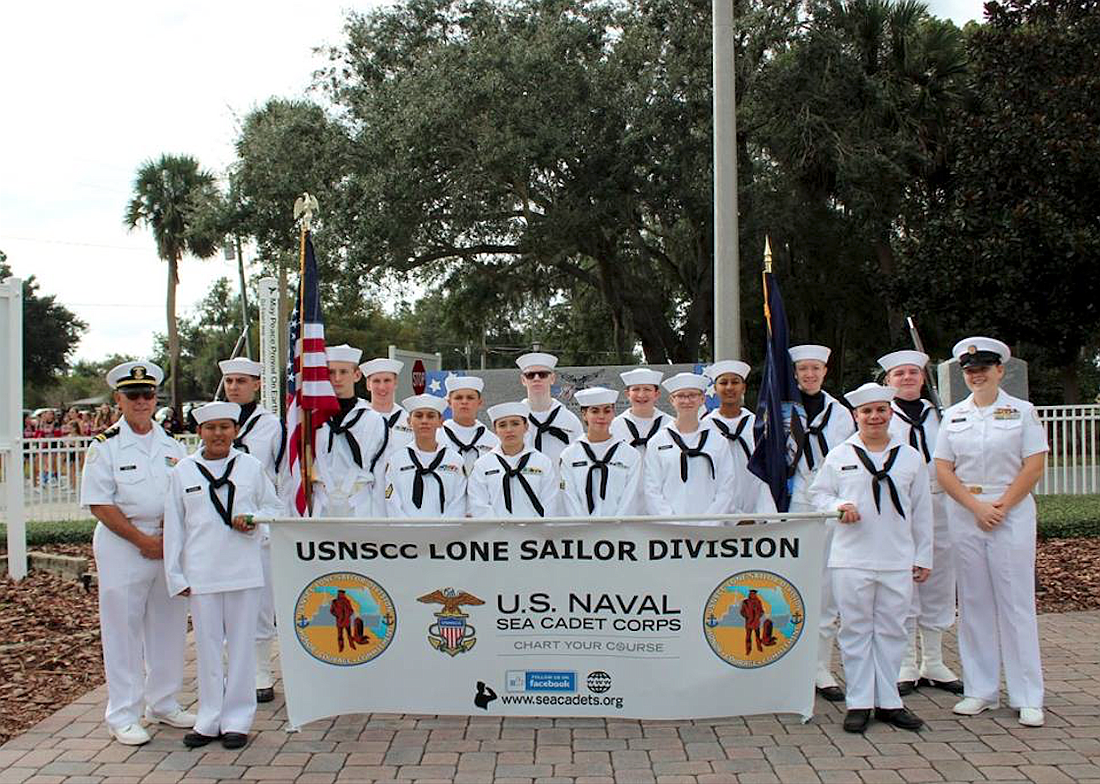- January 10, 2025
-
-
Loading

Loading

The teens are sweaty and sore when they come in from physical-training exercises. It’s hot outside, and these are military-caliber workouts.
But they’re still smiling, congratulating one another on a good workout session, looking fulfilled and ready to seize the day.
This group of 11- to 17-year-olds comprises the Lone Sailor Division, an Ocoee-based unit of the U.S. Naval Sea Cadet Corps program.
The USNCC was founded in 1958 by the Navy League of the United States at the request of the Department of the Navy. In 1962 it was chartered as a nonprofit youth organization with an emphasis toward the sea-going services of the U.S. It was only for boys up until 1974, when the law was amended to allow girls to participate.
The Lone Sailor Division is wrapping up its first year of operation. The group serves the community and the West Orange area by assisting in events as a color guard, parking attendants, ushers and greeters. They also help others through storm assistance and charity fundraising.
However, the division’s cadets also meet once a month during the school year for two eight-hour weekend drill days. They are exposed to a variety of training and activities, such as culinary and nutrition, STEM, cyber security, history and proper military etiquette and exercises. They also participate in a physical training hour on drill days.
ENS Rafael Lopes is the unit’s executive officer and oversees day-to-day operations. He estimates that he put in 800 volunteer hours in the last year, but the Lone Sailor Division and his cadets are worth the time.
“The Navy wanted to have a program to show the youth of the U.S. what maritime operations was all about and what the Navy did,” Lopes said. “There’s always been a belief that the military gives you an incredible (sense) of discipline and teamwork. Youth (have) become very isolated the last 50 years or so, and the idea is to take them and put them in a positive team.”
The local cadets train at the Vignetti Recreation Center in Ocoee. Currently, there are 18 members, but Lopes said it is expected to grow to at least 21 this fall. And although there is a military foundation, Lopes said the goal is to support each cadet and give him or her the tools necessary to be successful in their future endeavors.
Cadets have to pass the Navy’s physical-readiness test, and they also have volunteer instructors and real-life experiences. The cadets have done special workouts, toured a Carnival cruise ship to learn about ship operations, participated in Navy Seal-style PT and learned survival skills.
Instructor Michelle Schwab’s daughter, Seaman Olivia Schwab, will be 15 soon and has been a cadet for two years. Olivia said she wants to be a meteorologist or engineer in the Navy or Air Force and has learned much about aviation and leadership through the Lone Sailor Division.
“You can see the future is a lot brighter (through them),” Schwab said. “You want to teach them humility, failure and getting back up. Their faces when you encourage them and they’ve seen that they failed and now they fixed it … nobody’s perfect. Lots of these teens don’t understand anymore that they can’t be perfect, but they need to learn in an encouraging environment so they can pick themselves up and move on.”
Lopes’ son, Chief Petty Officer Carter Lopes, is 17 and has been a Sea Cadet for six years now. He wants to first obtain a bachelor’s degree in nursing but will join an ROTC program during college to become a commissioned officer in the Army. His goal is to join the U.S. Army Special Forces.
Additionally, Carter Lopes is one of only 16 cadets — out of the 20,000 nationwide — chosen for the international experience program. He will head to Hong Kong for one-and-a-half weeks in July to learn and serve as a diplomat for the Sea Cadets program and the country.
Another cadet from the Lone Sailor Division, Chief Petty Officer Renee Woods, also was chosen for the international experience program. She will be spending 16 days in South Korea. Chief Woods has been part of the Sea Cadets for eight years and was chosen to staff and participate in the Inbound International Exchange in 2018 when the United States hosted cadets from eight countries. Chief Woods also has trained aboard the USCGC Barque Eagle, the training tall ships sailing vessel of the U.S. Coast Guard Academy.